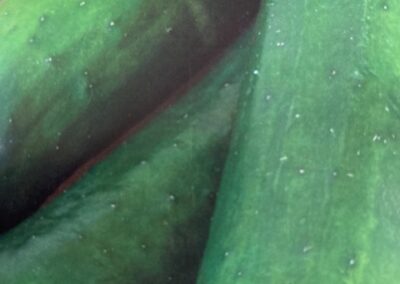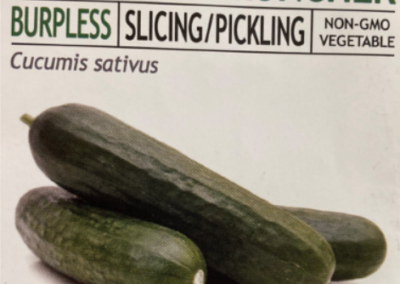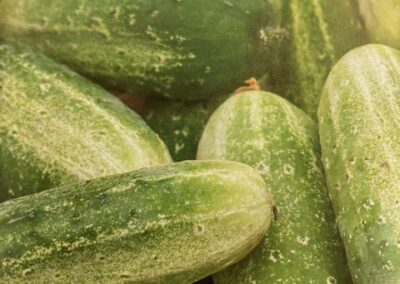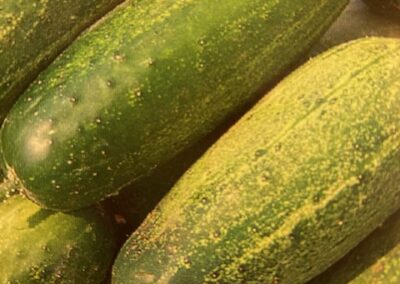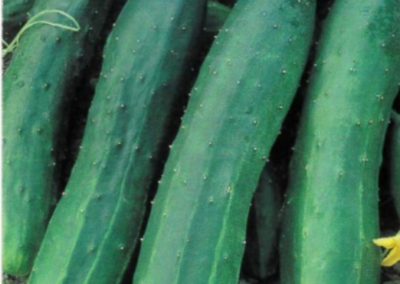
Cucumber
Crisp and refreshing, the cucumber is a relatively easy vegetable to grow. It can be eaten fresh, pickled, blended into smoothies, and even added to drinks.
|
New: Burpless Beauty New: Bush Champion Muncher; National Pickling; Picklebush; Poinsett 76; Straight Eight |
|
Cucumis sativus |
|
Intermediate to Easy |
|
Difficult |
|
Annual |
|
5-8 years if properly cured, cleaned and stored |
|
7-14 days |
|
Poinsett; Straight eight: 3-4′ Muncher: 4-5′ |
|
Full sun |
|
53-65 days |
|
|
|
April and May |
|
Yes |
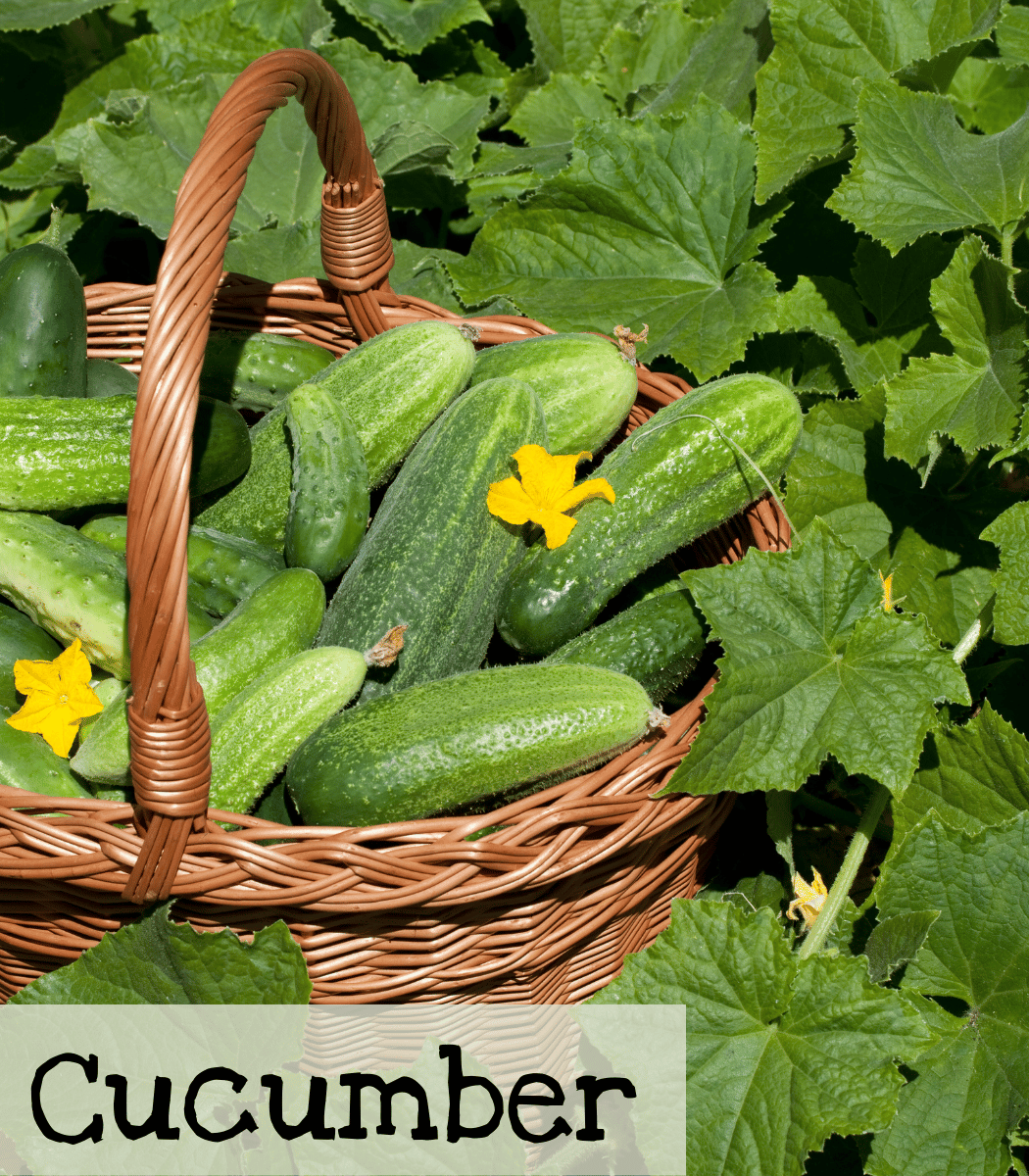
Growing Tips
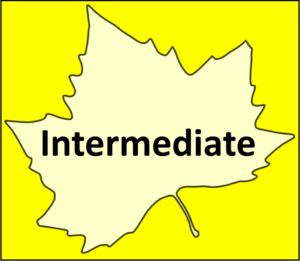


5+ gal container and trellis about 4′ tall.
When to Start
Spring: Direct sow after all danger of frost has passed. (April 1-May 15 GA)
Fall: Can be continually sown until 3 months before the first frost. (Ideal GA fall planting time is July 15-Aug 15.)
How to Start
Cucumbers can be started indoors 3-4 weeks before the last frost and then transplanted when they are 3 weeks old and all danger of frost has passed. Usually, they are directly sown after the danger of frost has passed. Keep in mind the seeds will not germinate if the soil is cooler than 65 F.
Sow 2-3 seeds to a depth of 1/2 inch in a full sun bed. Space plants about 2 feet apart and thin to the strongest seedling. Baker Creek states that cucumbers that stay in their pots longer than 3 weeks will be stunted and will grow slowly.
Care
Cucumbers like warm, humid weather; loose, organic soil; and plenty of sunlight. When planting cucumbers, choose a site that has adequate drainage and fertile soil. Keep the soil moist but not soggy.
Cucumbers may be planted in hills or rows. Since cucumbers are a vine crop, they usually require a lot of space. In large gardens, cucumber vines may spread throughout rows; within smaller gardens, cucumbers may be trained for climbing on a fence or trellis.
Training cucumbers on a fence or trellis will reduce space and lift the fruit off the soil. Trellising will also result in straighter fruit. This method also can provide your garden with a neater appearance. The bush or compact varieties are quite suitable for growing in small spaces or even in containers.
Harvest
Harvest cucumbers on the young side for the best flavor (before the seeds have matured). Avoid damaging the vine by cutting the cucumbers off with scissors. Keep harvesting to keep the plant producing.
Pest Management
They have many of the same pest problems as squashes and the same solutions to deal with those pests. Squash vine borers, aphids, and cucumber beetles are some of the most common troublemakers. Companion planting is an excellent way to combat these pests. Another solution is to use insect netting or shear curtains to keep the pests out completely, however, hand-pollinating will be needed for the fruit to be produced.
How to use
Cucumbers are delicious in fresh lettuce salads. There are also numerous cucumber salads from creamy to vinegar-based. They can be pickled and are popular in Greek cuisine.
My personal experience
I read that you can grow cucumbers in a large container with a trellis. So, I thought why not try it? You need a LARGE container. Mine will hold 2 cubic feet of dirt. I made a smaller and simpler trellis than the one I made for the asparagus beans.
I took 6, six-foot bamboo poles and wound about 10 feet of rope around the poles to make a teepee trellis. I then direct sowed 3-4 cucumber seeds.
The pot will only be able to support 1-2 plants. Any more and they probably won’t be healthy. So it’s important to thin to 1-2 plants.
I also always plant some kind of flower in the pot too. I like to use alyssum and bush naturtiums. This is to make sure the pollinators come and pollinate. The one time I didn’t do this, I didn’t get good pollination.
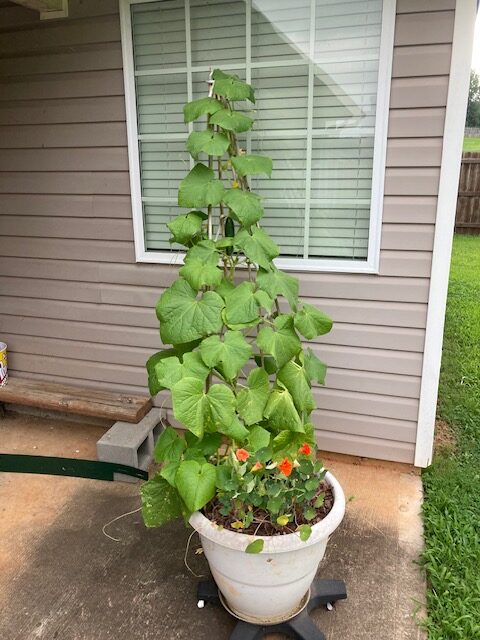
Seed Saving
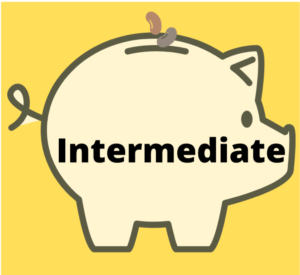
Isolation Distance
Separate varies of Cucumis sativus by one-half mile or cage and hand pollinate.
Instructions
Cucumbers should be fully mature before harvesting. Harvest cucumber seeds 5 weeks after the fruit’s edible maturity, when it changes color to yellow, white, orange, or brown. Store the unopened fruits for an additional 20 days before removing the seeds.
Scoop the seeds—together with the pulp that surrounds them—into a jar or bowl with a little water (about half as much water as seeds and pulp). Remove the seeds that float and pulp. Viable (good) good seeds will sink to the bottom. Pour the viable seeds into a colander.
Rub them underwater between your fingers gently but thoroughly while cleaning them, to remove the naturally occurring gel from their coats. Dry the cleaned seeds on a shiny surface (they will stick to paper) until they are brittle.
Features
- Muncher: Good for slicing.
- National Pickling: Heirloom. Good for canning.
- Picklebush: Good for canning.
- Poinsett 76: Heirloom. Good for slicing. Released in 1976, the Poinsett 76 is an improved version of the Poinsett Cucumber that is resistant to most cucumber diseases such as downy mildew, powdery mildew, angular leaf spot, and anthracnose.
- Straight Eight: Heirloom. Good for slicing.
- Burpless Beauty: Stays firm and crisp longer and is easier to digest.
- Bush Champion: A Bush variety that is great for containers.

- When growing in a container, once the plant has reached the height you want, clip the terminal growing point at the end of the vine. This will stop the upward growth and help encourage bushiness.
-
I have lots of flowers but no fruit
Cucumbers have both male and female flowers. If the plant is not setting on fruit, it could be a pollination issue. There are a couple of things you can try. Try planting some flowers in with the cucumbers to attract pollinators. I like to plant bush nasturtium with my cucumbers. It’s an edible flower and it’s also a good companion plant. Also, try hand pollinating. It’s very easy to do and is done the same way as zucchini and other squashes. See Zucchini Pest Prevention for how to hand pollinate.
You May Also Like:
How to Hand Pollinate: Zucchini Pest Prevention
Companion Planting: How to use flowers to help control pests

